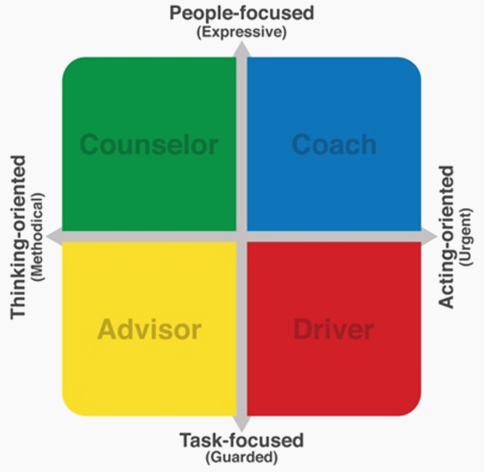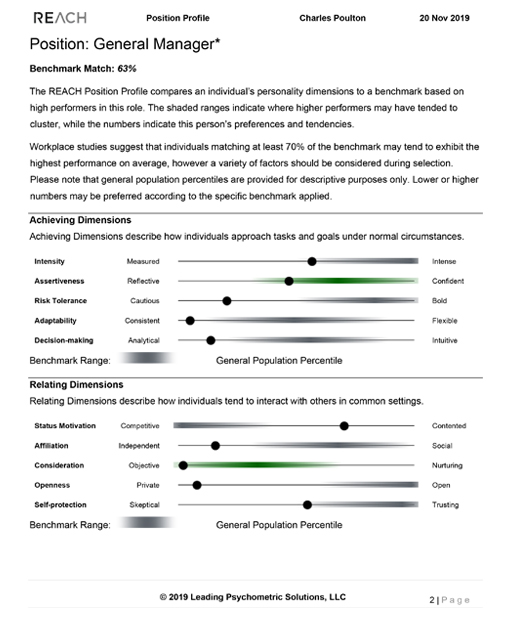
Hiring the right new people for your team is a critical and difficult step. Using REACH profiles within the Ecosystem you can get it right more often by understanding the strengths, tendencies and team fit.
REACH Profiles allow you to develop both a big picture view of a persons style, and then take a deeper look at the 10-dimensions of their personality and how they approach life and work.
Some unique features of the REACH Hiring profiles are:
The REACH assessment takes candidates 10-12 minutes in a mobile-friendly, and automation produces all the complementary reports simultaneously - including the Personal Development Companion, and the Team Visualizer, using REACH Hiring Profiles takes the use of validated reliable psychometrics to the next level of functionality and benefits.
The clean simple visuals and straight forward language make this resource something that people enjoy using. See the different approaches to improving your recruitment processes using REACH below.
The REACH framework provides a big picture overview of a person's overall style by placing them on a 2x2 4-coulor grid below and then more granular detail helping you really understand a person's unique personality using the 10-dimensions that make up the layers of their unique personality.



These 10 dimensions all have advantages at either end of the continuum and at the moderate position depending on the role and context.
In a hiring and selection context, they help us identify the natural inclination of a person and help us further explore what their natural tendency would be. We can gain insights to their most common approach vs the approach that is most suited to the situation they will work within. It helps us ask more probing questions to see if the environment they are entering will be a natural fit, an exciting invigorating challenge, or simply not a long-term mutually rewarding match.
Below describes the two most common uses of REACH Profiles (and psychometric tools in general) during hiring and selection:
In this approach, the hiring manager is provided with a visually clear, statistically valid, 1-page report on how closely the applicant matches the profile of the highest performing people in the same role at the same organization.

A minimum of 60 incumbents take the REACH Profile.

Using your performance data (the information you use to rate performance - for example long tenure, high customer satisfaction, strong appraisal scores, high sales, low error rates), our Professor undertakes the analysis to identify distinguishing traits that are common across the high performers, and correlation between performance.

Then we provide you with a Role Profile of your high performers and a report to show the underlying analysis.
This has a once-off cost of USD$5,500 and can take up to 1-month.

In this approach, the Hiring Manager looks at the 10 Style Dimensions of a candidate to identify areas that could be explored further to be more confident of a good match for the specific needs of the business.
This approach is most useful to explore ‘fit’ of a highly capable person to the specific needs of the business.
The application is situationally specific and infinitely variable. Here are some examples of how Situational Interpretation could be used:

Selecting a leader in the highly-regulated financial industry.
On the surface, would you seek someone with a Risk Tolerance rating of Cautious or Bold?


Selecting a sales person to work from their home office selling into a territory with a lot of outbound calling.
On the surface, would you seek someone with an Affiliation rating of Independent or Social?


Selecting a customer service officer to join during a period of significant change with new systems, mergers and many new products and services being launched over the next 12-months.
On the surface would you seek someone with an Adaptability rating of Consistent or Flexible?


Selecting an analyst whose role is focussed on careful, detailed analysis and preparation of carefully considered, detailed reports.
On the surface would you seek someone with a Decision-Making rating of Analytical or Intuitive?

Adding value to selection using both Scientific and Interpretive approaches is common practice and is a great use of psychometrics. However, information provided in either approach should not be how decisions are made, interpreting a report as the desicion-making tool would be considered misuse of the tool. There are many reasons why psychometric instruments should not be used as the decision making tool.
Firstly, it describes a person’s most common natural style, it doesn’t mean they can’t or wouldn’t be able to perform well. Additionally, there are many aspects of a person beyond personality that are equally or more important.
For example, if your organization communicates in a particular language, and the candidate doesn’t speak or read that language, their natural style will be of very low importance compared to the language barrier. This is a simple example, however there are always many other factors to consider than just personal style so these tools should always be used only as an additional piece of information.
Proper use of any psychometric tool is to provide the recruiter/interviewer with prompts to begin more explorative and purposeful interviewing to help make a more informed hiring decision - not to ‘make’ a decision.